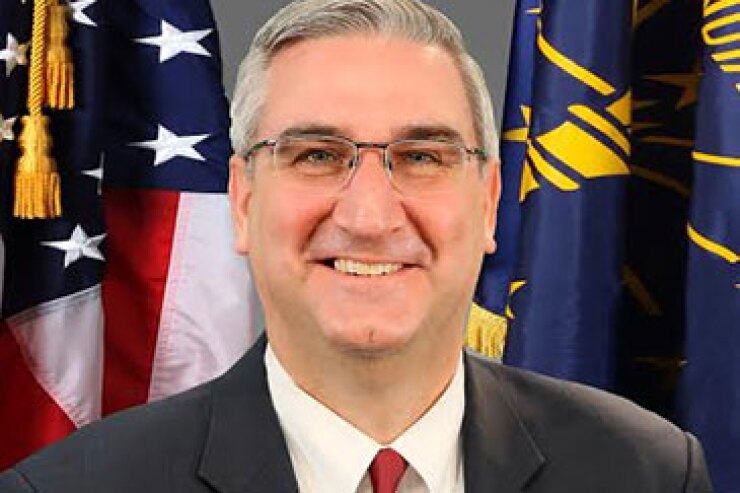
DALLAS –Indiana's new governor, Eric Holcomb, unveiled a nearly $31.8 billion, two-year spending plan he said achieves his education funding and economic development goals while preserving the state's reserves and top credit marks.
The budget released one day after Holcomb's swearing in Monday also appears in line with the list of priorities Senate Republicans outlined in their agenda this week. Holcomb is a Republican and the GOP controls the legislature.
The budget calls for spending $15.6 billion during 2018 budget year that begins July 1 --an increase of 2.3 % over current appropriations, and $16.2 billion in fiscal 2019, a 3.1 % boost over 2018.
"This proposed budget achieves all of my objectives: It is honestly balanced, maintains prudent reserves, and preserves our AAA credit rating. It continues support for what's working in our state while funding key priorities to take Indiana to the next level—long term funding for roads and bridges, high-quality education opportunities to prepare Indiana's rapidly changing workforce, a strong focus on attacking Indiana's drug epidemic, and great service to Indiana citizens. I look forward to working closely with state lawmakers in the weeks ahead, and I'm confident we'll conclude this session with a budget that meets our key priorities for Indiana's future."
The proposed budget would leave a roughly $84.6 million surplus at the end of fiscal 2018 and $197.5 million at the end of fiscal 2019. The plan would leave $2 billion in reserves in 2019. The state's last budget projected $1.8 billion in reserves but closed fiscal year 2016 with a slight surplus allowing the reserves to reach $2.24 billion.
The budget also makes targeted investments in specific projects likely to produce long-term economic benefits for the state.
One such appropriation is $10 million in fiscal 2019 support to help fund the double-tracking of the South Shore commuter rail line between Gary and Michigan City. The existing line runs from downtown Chicago to Michigan City on the far northeast border of the state with Michigan. A similar appropriation would be allocated in future years.
Funding for kindergarten through 12th grade education, the state's largest expense, would increase 1% to $7.05 billion for the 2017-18 school year, and another 2% to $7.2 billion in 2018-19.
Holcomb is also proposing spending $1 billion over the next ten years to fund investments in entrepreneurship and to support early-stage and mid-size Indiana companies. The plan is similar to one proposed by his predecessor, former governor and now vice-president elect Mike Pence, in July. However Holcomb wants to fund half of the plan with funds from Indiana's next level Indiana trust fund, which was set up years ago from proceeds of the Indiana Toll Road Lease. Pence's proposal called for tapping the Indiana Public Retirement System.
The trust fund, established with proceeds from the 2006 Indiana Toll Road lease, currently must be invested in products with extremely limited risk. Lawmakers must approve converting the trust to support entrepreneurship in the state. Interest generated from the Next Generation fund annually, which is about $20 million, is used for road funding now and that would continue under Holcomb's plan.
Holcomb is also looking to venture capital investment tax credit transferability as a way to fund the proposal. Indiana has a $12.5 million venture capital tax credit program that benefits only investors with tax liability in the state. Holcomb wants out-of-state investors to be able to sell their tax credits to people and companies that have tax liability in Indiana to generate more money for companies based in the state.
He's also calling for continued state spending of $30 million a year to go toward the fund and a $100 million investment by the state over 10 years in partnerships with higher education and research institutions that would educate and support entrepreneurs.
Holcomb also will press for a long-term approach to funding Indiana's roads and bridges. Though he didn't lay out any plans on funding in Tuesday's budget announcement, he has said he supports the plan put forward by House Republicans last week.
Indiana House Republicans introduced a $1.2 billion per year transportation funding proposal that raises the state gasoline tax and require transportation planners to study the tolling of Indiana's interstate highways.
The 20-year plan would raise the state gasoline and diesel taxes by 10 cents per gallon, levy a new vehicle fee of $15 per year dedicated to transportation infrastructure improvements, and add a $150 per year registration fee for electric vehicles.
His budget and agenda are in line with the legislative agenda rolled out by Senate Republicans on Tuesday.
"The agenda unveiled today by Senate President David Long keeps our fiscal house in order while advancing key priorities, like long-term funding for roads and bridges, preparing a 21st century workforce, and attacking the drug epidemic," said Holcomb. "Again, I am encouraged by the leadership shown by the state's legislative leaders and pleased to see we are all working from the same page to build upon our state's strong economic position and improve Hoosier lives."
The state closed out fiscal 2016 with a structural surplus of $50.6 million, $545 million in its rainy day fund, and a total of $2.24 billion in various state reserve accounts.
Revenue in the fiscal year that ended June 30 finished $111.3 million below a revised forecast and $78.5 million below revenue collected in fiscal 2015.
Indiana holds triple-A ratings from the three largest rating agencies. S&P Global Credit Ratings reaffirmed Indiana's AAA credit rating in April and Fitch Ratings reaffirmed the state's AAA credit rating in June.





